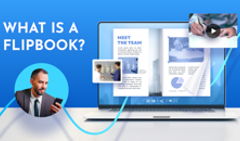What is the first format you think of when you need to create and share content? It’s PDF most of the time, isn’t it? No wonder, because PDF has been the main document format for years.
However, with the rise of digital technologies, PDFs leave much to be desired. They’re plain, hard to share because of their size, not optimized for the web and mobile devices, and not accessible, just to name a few. After all, Adobe created PDF 30 years ago and since then the web has changed, and so has content consumption.
That’s why many companies are looking for PDF alternative formats—and even Adobe Acrobat Alternatives—that can serve as a great substitute and help companies achieve their goals much better than PDFs. So in our blog post, we’ll talk about the benefits of using PDF alternatives and share the formats that you can switch to from PDFs to empower your documents. We hope that you will find the format that suits you best! Let’s get right to it, shall we?
Why Use Alternative PDF Formats
🧰Functionality
One of the fundamental reasons to choose PDF alternatives is that PDFs lack the functionality and reading experience of 21st–century content. PDFs are slow to load and consume a lot of memory, they lack convenient navigation and aren’t tailored for mobile devices. While alternatives to PDF can offer many features to help you create state-of-the-art content: your online documents can be engaging and interactive, you can share them via a link no matter their size, they are comfortable to read and navigate around, and are adapted for any screen and device.
🔒Security
Security is what every document needs today and PDF isn’t something that can provide it. If you share sensitive information like an internal report or business proposal in the PDF format, there’s a high risk that it can be leaked in one way or another. You can’t restrict a PDF from downloading or printing. Of course, you can password protect it in Adobe Acrobat but some PDF viewers ignore this setting, so it’s not as helpful as you’d hope. Alternative PDF formats allow you to protect your content from downloading and printing, add a password, make your document available only on your website with the help of a protected embed, and more.
👓Accessibility
Another reason to go with PDF alternatives is that consuming your content in the PDF format can be inconvenient for people with disabilities. Creating accessible PDFs that are fully compliant with the accessibility standards is quite challenging as PDFs are complex and not accessible out of the box. Making them so requires lots of time and effort. Other formats such as HTML are more accessible for any individual with any kind of disability as they can provide an alternative way of accessing the content. For instance, such formats can be easily read by screen readers and can be navigated with a keyboard instead of a mouse.
📈 SEO Optimization
When you create PDFs, they are not SEO optimized by default so you have to optimize your PDFs manually. But even though Google will index your PDFs better, your PDFs won’t rank as high as you’d like them to be ranking. Formats like digital flipbooks and HTML will rank higher than PDFs because their smart promotion systems will be giving the documents a strong SEO boost.

So now that you know about the main benefits of PDF alternatives, check out what amazing interactive formats you can use to take your content to a whole new level.
Top PDF Alternatives for Modern Content Sharing
Choosing the right format for your content can make a big difference in engagement, reach, and effectiveness. Here’s a quick comparison of common PDF alternative formats—EPUB, Google Slides, Flipbook, and HTML—across key dimensions like interactivity, security, and SEO.
| Format | ✨ Interactivity | 🔒 Security | 🔄 Ease of updating | 🌐 SEO |
| EPUB | ⚠️ Low-Medium | ⚠️ Medium | ⚠️ Medium | ⚠️ Low-Medium |
| Google Slides | ⚠️ Medium | ⚠️ Medium | ⚠️ Medium | ⚠️ Low |
| Flipbook | ✅ Excellent | ✅ High | ✅ High | ✅ High |
| HTML | ✅ High | ⚠️ Medium | ✅ High | ✅Excellent |
And now, let's look at each of the PDF alternative formats more closely.
🌟EPUB
After more than a decade since PDF originated, ePUB was developed by the International Digital Publishing Forum and became the standard format for digital publications. The main feature that differentiates ePUB from PDF is its ability to reflow its content. When you open a PDF document on a small screen, you have to make an effort to be able to read the document: zoom, scroll, and whatnot. On the contrary, an ePUB document fits smoothly around the screen because of its reflowable nature. The content on the page rearranges and realigns itself so that the user can have a good reading experience.
What’s more, ePUB is designed keeping eBook readers in mind the so it’s better suited for eReaders. XML and XHTML make ePUBs accessible and compatible with most of software tools. You can read an ePUB document on a computer, tablet, smartphone, and any eReader (except Kindle).
🌟Google Slides
If you want to build simple presentations, portfolios, invitations, and brochures, you can do it in Google Slides right in your web browser. No need to buy Adobe Acrobat and learn how to create PDFs there. Google Slides allows you to express yourself, your data, and your ideas easily with presentation themes, various fonts, and graphics. Plus, multiple people can work on slides at the same time, you can see people’s changes as they make them, and every change is automatically saved. And your Google Slides documents are very fast to share via direct links.
🌟Flipbook
A flipbook is an interactive digital publication with a realistic page-flip effect that makes it resemble a real print copy. There are various flipbook creators that can help you convert your PDFs into online documents in a few clicks. In our article, we’ll be talking about flipbooks, made with FlippingBook, an online flipbook maker. Just check out how nice your online document can look.
Sunrise Health Community Report
Create your flipbook in seconds
A digital flipbook provides a great reading experience on any device and can be easily shared via link or embedded into a website. This document format stands out from other interactive PDF alternatives: not only is it aesthetically pleasing to read but it also offers many powerful features for marketing and sales, as a one-stop shop. Here are just a few of them:
✨Interactivity
Did you know that audiences spend 73% more time engaging with interactive digital content than with static PDFs? A study by the content creation platform Turtl highlights just how powerful interactivity can be. With flipbooks, you can easily turn your static PDFs into dynamic, engaging experiences. Add interactive elements such as:
- Videos that bring your story and ideas to life.
- Animated GIFs for a touch of movement and visual appeal.
- Pop-up images and galleries for a rich, immersive experience.
- Forms and quizzes to connect directly with your audience.
- Outbound links that guide readers to explore more of your content.
These features make your flipbooks stand out and keep readers coming back for more.
📤Easy sharing
Forget about bulky attachments and download links—sharing your content can be seamless and elegant. With flipbooks, you can:
- Send a direct link via email or messenger.
- Share on social media with a clean, clickable preview.
- Embed your publication directly into your website.
- Add a QR code to printed materials so readers can instantly open your flipbook on any device.
Your content becomes instantly accessible, beautifully presented, and easy to share anywhere.
🛡️Content security
Unlike traditional PDFs, flipbooks give you full control over who can view and share your content. With FlippingBook, you can choose the desired level of privacy for your documents. Protect your publications by:
- Setting custom privacy levels—from private links to password protection.
- Using protected embeds that only work within your website.
- Disabling share, download, and print buttons to prevent unauthorized access.
- Allowing access only to verified users via email, domain, or SSO (Single Sign-On).
This way, your content remains secure while still being convenient for your audience to view.
🌟HTML
HTML is a markup language that allows for the creation of web pages and structured documents with text, images, and other multimedia elements. By the way, flipbooks are also HTML-based, so they combine the features of flipbook and HTML formats. HTML provides several benefits over PDFs for digital content:
- It is designed to be read by screen readers and other assistive technology, making it a more accessible format for people with disabilities.
- HTML is easier to produce, edit, and update than PDFs because it is a text-based format that you can update and change anytime using a simple text editor.
- HTML is responsive, as it adjusts to different screen sizes and devices, making it easy to view your content on smartphones, tablets, and desktops.
If your work still requires working with PDFs but you don't want to use Adobe Acrobat Reader, check out list of the best Adobe Acrobat Reader alternatives.
Efficient, Affordable Alternatives to Adobe Acrobat
Foxit PDF Editor
Foxit PDF Editor is widely regarded as one of the most robust alternatives to Adobe Acrobat, especially for professional and business users. It offers a suite of tools that lets you create, edit, annotate, and organize PDF files with ease. The interface is intuitive and resembles Microsoft Office, which makes the transition smoother for new users. Foxit also includes advanced features such as OCR (Optical Character Recognition), form creation, and e-signatures.
Smallpdf / iLovePDF
Smallpdf and iLovePDF are two popular web-based tools that provide a wide range of PDF utilities. Both platforms offer a user-friendly interface where you can merge, split, compress, convert, and e-sign PDF documents. They’re ideal for users who need to perform straightforward PDF operations quickly and don’t require heavy-duty editing tools.
Nitro PDF Pro
Nitro PDF Pro is another Adobe Acrobat Reader alternative aimed at business and enterprise users. It offers a comprehensive set of tools that rival Adobe’s capabilities, including document editing, e-signatures, collaboration features, and batch processing. The interface is clean and productivity-focused, with a ribbon-style layout familiar to Microsoft Office users.
FAQ: PDF Alternatives
1. What are some common alternatives to PDFs?
Common alternatives include HTML/web pages, EPUB ebooks, slide decks, and digital flipbooks. Each format has different strengths, such as interactivity and easy sharing for flipbooks, reflowable text for EPUB, or visual storytelling for slides.
2. Why might I choose a format other than PDF?
Alternatives can be more interactive, mobile-friendly, or easier to update. They can also provide better analytics, engagement tracking, or SEO benefits compared to static PDFs.
3. Are flipbooks a good option?
Yes, flipbooks combine the familiarity of PDFs with interactivity, tracking, and web-friendly accessibility, making them especially useful for marketing, sales, HR, and education.
4. Can web-based formats replace PDFs entirely?
In many cases, yes. Web formats are easy to share, adapt to different devices, and allow live updates, though PDFs are still useful for offline or printable versions.
5. How do I decide which format to use?
Consider your audience, content type, and goals. If engagement and interactivity matter, flipbooks or web formats work best. For offline reading or legal documentation, PDFs may still be necessary.
That’s it! We hope that you will find a PDF alternative format that will up your content game and help you achieve more with your business. Good luck!




